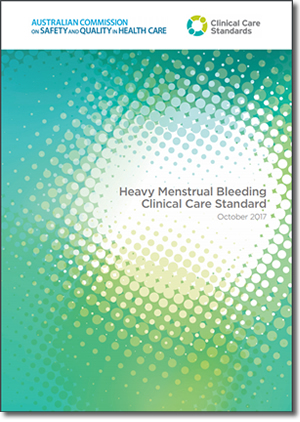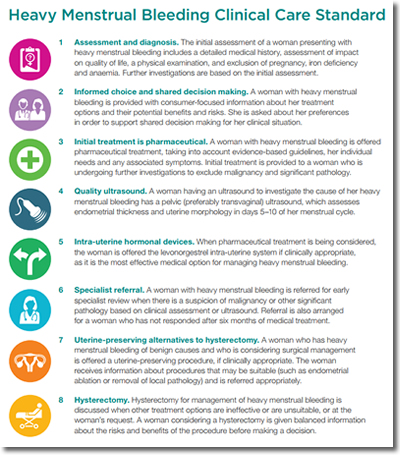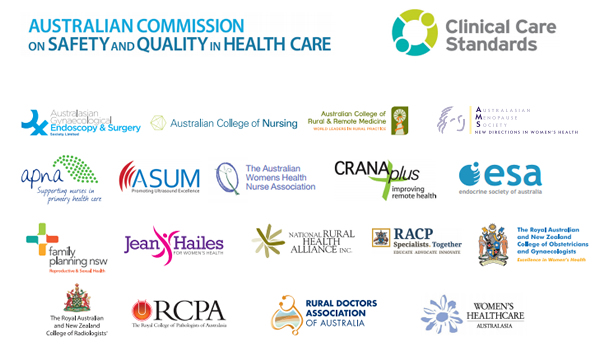Heavy Menstrual Bleeding Clinical Care Standard 2017
7 December 2017:
 The first nationally agreed standard of care for women with heavy menstrual bleeding was launched by the Australian Commission on Safety and Quality in Health Care on 20 October 2017. The new standard aims to improve women’s health across Australia for this potentially debilitating and under-recognised condition.
The first nationally agreed standard of care for women with heavy menstrual bleeding was launched by the Australian Commission on Safety and Quality in Health Care on 20 October 2017. The new standard aims to improve women’s health across Australia for this potentially debilitating and under-recognised condition.
The Commission developed the Heavy Menstrual Bleeding Clinical Care Standard (https://www.safetyandquality.gov.au/publications/heavy-menstrual-bleeding-clinical-care-standard/) in collaboration with women’s health experts and consumers, and it has endorsement from eighteen leading professional organisations including the Royal Australian and New Zealand College of Obstetricians and Gynaecologists and the Australasian Menopause Society.
Heavy menstrual bleeding is a common problem affecting about 25% of women of childbearing age. Although many women seek medical help because of pain, others do not seek help despite significant impact on their social, emotional and physical wellbeing, possibly because they are unaware of the wide range of effective treatment options that are available.
While surgical removal of the uterus (or hysterectomy) was the mainstay of treatment at one time and is sometimes still appropriate, a range of other evidence-based treatment options have been more recently developed and are – or should be – available when clinically appropriate. These include pharmaceutical treatments and ‘minimally invasive’ gynaecological procedures.
Evidence suggests that many women in Australia may not be aware of these newer, less invasive treatments, or are not being offered them. The Commission’s Australian Atlas of Healthcare Variation shows that women in some parts of Australia are up to seven times more likely to have their uterus removed than in others.1 Regional areas have higher age-standardised rates of hysterectomy than major metropolitan cities2 and Australia has higher rates of hysterectomy than the UK and New Zealand.3 In contrast, rates of endometrial ablation vary twenty-one fold with some regions having very low rates compared to other similar regions. The Interactive Atlas of Healthcare Variation developed by the Commission can be used for local area comparisons of these hysterectomy and endometrial ablation rates.1
In view of the Atlas findings, the Commission developed the Heavy Menstrual Bleeding Clinical Care Standard to support high-quality, safe and appropriate care for all Australian women with this problem regardless of where they live. The standard aims to ensure that all women with heavy menstrual bleeding are aware of their treatment options and are able to participate in decisions about their treatment.
Health services, local hospital networks and primary health networks and clinicians can use the standard and supporting quality indicators to support best practice care and service delivery.
Most women with heavy menstrual bleeding can have it effectively managed with good general practice care. This requires a comprehensive history and assessment as well as an understanding of the woman’s treatment goals. The most appropriate treatment will differ for each woman and depending on the cause of the condition, other medical problems, and whether she wishes to become pregnant in the future.

The 8 standards are:
- Initial assessment including a detailed medical history, physical examination and understanding of how it impacts on quality of life.
- Explore available treatment options with the patient, explaining their benefits and risks, allowing the woman to share her preferences for treatment options.
- Offer pharmaceutical treatment based on her individual needs and symptoms.
- Opt for a transvaginal or pelvic ultrasound to investigate the cause of the heavy menstrual bleeding, between days 5-10 of cycle to assess endometrial thickness and uterine morphology.
- Offer levonorgestrel intra-uterine device if clinically appropriate.
- Refer to a specialist if there is suspicion of malignancy or significant pathology, or the woman hasn’t responded after six months of medical treatment.
- Consider uterine-preserving alternatives to hysterectomy, such as endometrial ablation or removal of local pathology.
- If other treatments are ineffective or not suitable, or at the woman’s request, consider hysterectomy to manage heavy menstrual bleeding.
The clinical care standard promotes informed choice and shared decision making, which are crucial to appropriate treatment of heavy menstrual bleeding. There is evidence that women tend to choose less invasive treatment options when they are informed about them and are asked about their preferences.4 Less invasive surgical interventions include endometrial ablation (surgical removal of the lining of the uterus), and the removal or destruction of fibroids or polyps using surgical or radiological techniques.
The standard has identified some other specific areas for improvement including the timing of transvaginal ultrasound. When imaging is required, ensuring that gynaecological ultrasounds are optimally timed in the menstrual cycle and reported in line with quality practice standards reduces the need to repeat this relatively invasive procedure, related costs and delays.
Indicators have been developed alongside this clinical care standard to support ongoing measurement and quality improvement by health services and primary health networks which choose to use them. Health services undergoing assessment using the National Safety and Quality Health Service (NSQHS) Standards can use the clinical care standard to demonstrate evidence-based clinical care.
The Commission’s role is to lead and coordinate national improvements in the safety and quality of health care. The Commission works in partnership with the Australian Government and state and territory health systems to achieve a sustainable, safe and high-quality health system. In doing so, the Commission also works closely with patients, carers, clinicians, managers, policymakers and healthcare organisations, including those in the private sector.
- Australian Commission on Safety and Quality in Health Care and National Health Performance Authority. Australian Atlas of Healthcare Variation. Sydney: ACSQHC, 2015.
- Australian Commission on Safety and Quality in Health Care and Australian Institute of Health and Welfare. The Second Australian Atlas of Healthcare Variation. Sydney: ACSQHC, 2017.
- Australian Commission on Safety and Quality in Health Care and Australian Institute of Health and Welfare. Exploring healthcare variation in Australia: analyses resulting from an OECD study. Sydney: ACSQHC, 2014.
- Kennedy AD, Sculpher MJ, Coulter A, Dwyer N, Rees M, Abrams KR, et al. Effects of decision aids for menorrhagia on treatment choices, health outcomes, and costs: a randomized controlled trial. JAMA 2002;288:2701-8.

Content updated 7 December 2017
